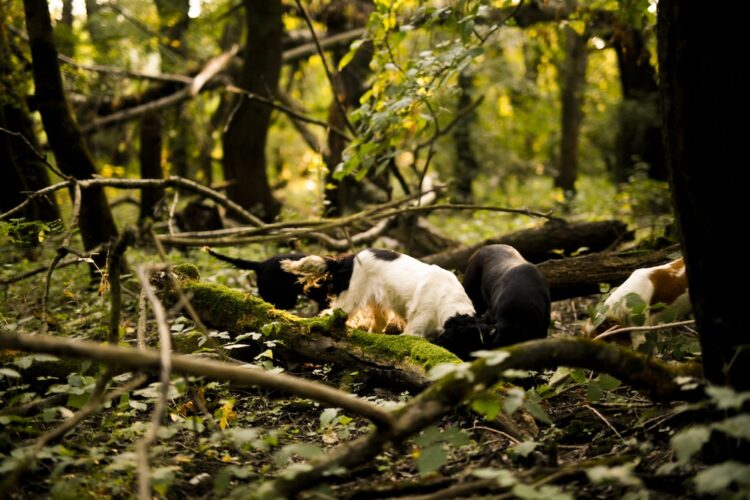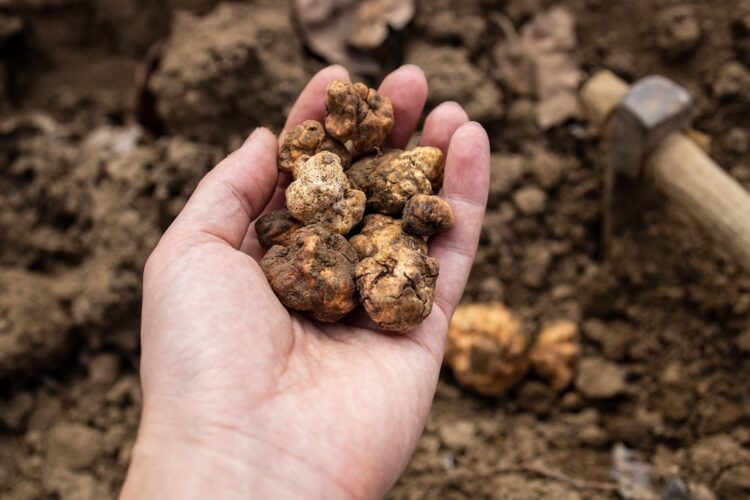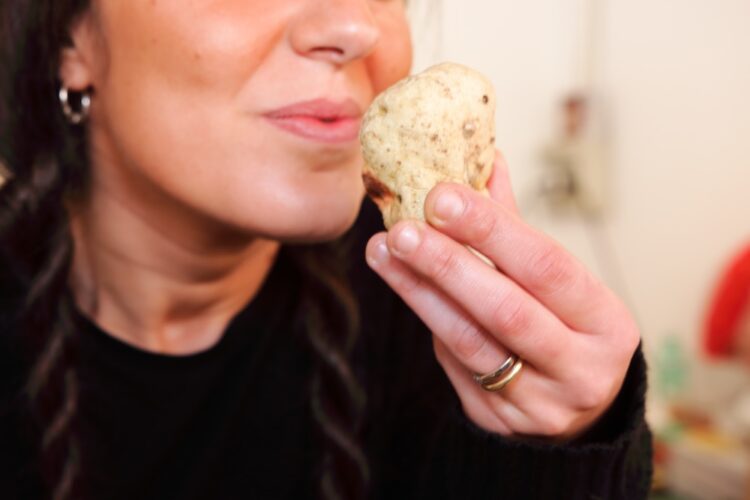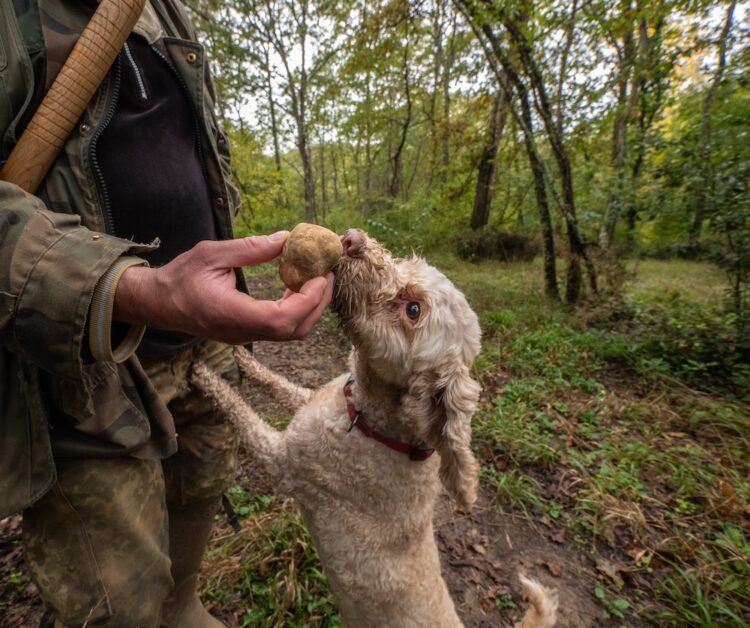I’m walking through Pettino’s truffle-rich forests and pastures at the base of a mountain. Leading the way are four hyped-up dogs – Pucci, Pippo, Vespa, and Enea; hot in their heels are truffle hunters Luciano and Bruno, armed with small picks and a leather bag for the loot.
Truffle hunting is a centuries-old daily tradition, a daily event which, for the dogs and their handlers, is a time to demonstrate their kinship, their bond. These dogs have been specially trained to sniff out Umbria’s prized pungent condiment.
Here, next to the river, we’re searching for white truffles, the rare bulbous tuber that cannot be cultivated like their black counterpart. The dogs seek out the white diamonds – snout to the ground, then dig frantically when they make a discovery.
Luciano and Bruno traverse the soil carefully with their dogs, one of which is a curly-haired Lagotto Romagnolo, a breed famed for its truffle-detection abilities.
Pucci disappears into the undergrowth, quickly followed by Bruno, her handler. He produces his vanghino, a specialist excavation tool, and unearths an onion-sized white truffle. This excites Pucci as she knows what’s coming – a treat in the form of a dried pasta.

The Italian law on truffles allows only highly trained dogs who love their jobs sniffing out truffles. These tend to be traditional water dog breeds like Pointers, Spaniels and Setters. In theory, this can take place at any age, although the best results are attained in three- to six-month-old pups.
Finding just a handful of truffles in our hour-long trek, the dogs are transported to the nearby estate of San Pietro a Pettine, higher up the mountain. Here, we’ll set out to find black truffles, which are buried among roots in select patches of hillside oak and hazelnut groves.
It’s a beautiful and simple way of life – the secluded Umbrian mountains, the ancestral hamlet that’s been home to truffle hunters since the 15th century.

“Truffle hunting is an everyday part of our lives,” says steely-eyed Bruno. He rummages in his deep pocket and produces a dried pasta treat for an excited Pippo. “We go truffle hunting almost every day. We are the caretakers of the truffle mountain and truffle forests; we are the keepers of many generations of truffle recipes; we eat truffles, we produce condiments from truffles, and we sell truffles. This is how we live.”
He continues and explains that truffles exude a chemical that imitates the mammalian reproductive pheromones. Just sniffing it is akin to being drugged. Initially, female pigs were used to find truffles, but when they latch onto the irresistible and sexy truffle aroma (which contains twice as much male pig hormone as male pigs do), they’re driven wild and often eat their find. This gave rise to the training and use of truffle hunting dogs.
We’d just started speaking about the black truffles per kilo price – which is in excess of £250, when Bruno, always poised to sprint whenever he hears frantic digging among the oaks, sets off in search of Pippo. He says Pippo tends to consume truffles, so he must stay alert to her find.
It gladdens my heart to watch the hunter and his dog, both from an ancient lineage of truffle hunters, exhibiting age-old techniques.
Bruno emerges from beneath the undergrowth, holding a mall onion-sized white truffle between his thumb and index finger. “This”, he claims,” is ten times the value of black truffles.” He hands it to me. I feel its weight in my palm, give it a deep sniff, which emits a scent of incredible intensity that’s best described as luscious, hypnotic, slightly garlicky with deep musky aromas that are deliciously funky. All this, Bruno assures me, helps uplift flavors when cooked with other ingredients, enhancing the texture of every mouthful and leaving a lingering aftertaste.
Umbria is the single largest producer of truffles in Italy. In meeting the worldwide demand of international chefs, professional truffle hunters can earn up to £20,000 a season. Their finds are passed along a series of uber-competitive and guarded truffle-market channels before they land on dinner plates abroad.
The two truffle hunters place their bounty on a table near the estate’s tiny chapel. A fitting location, I thought, as here truffles are the essence of life itself. Chef Alicia Capuricci of La Cucina, the estates restaurant, examines the truffles closely, extracting the ones she’ll use to create lunch.
The aromas emanating from the approaching plate are sensual, other worldly! It’s a hypnotic, sulfuric love bomb you’d want to wear as a perfume, roll in its essence.

It all kicks off with an egg that’s been slowly poached for 90 minutes, coated in panko, deep-fried, then served atop creamy mashed potato. It’s accompanied by a parmigiana fondue and a heavy hand of white truffle shavings (the very same truffle we’d just brought in from the woods). It requires just one taste and you’re hooked. It’s oaky, nutty, a little earthy; it’s juicy and sweet with back notes of olives.
The rest of the menu is a truffle blur. Demonstrating her skills in extracting the full effect of the fungi, Chef Alicia uses it by the handful, treating the pricey orb like a vegetable. She shaves it onto just about anything – including ice cream. www.lacucinadisanpietroapettine.com
“Black truffles spores smell stronger than the flavour but even the strongest black truffles will never overpower other ingredients on the plate,” says Chef Alicia.
Later, at La Pintura, my farm stay near Trevi – Nonna Ciarletti is making dinner. I’m sitting at a battered 10-seater wooden table beside a slow-burning log fire. Gianfranco Ciarletti, my host and 4th-generation olive farmer, is having an animated discussion with Nonna about dinner.
It’s a harmonious mix of brochette toasted on open coals, wafers of cured ham, topped off with lashings of home-grown olive oil. Then the soul food makes an appearance – a dense vegetable broth with a fist full of grated truffles and parmesan cheese dropped on top, plus a good glug of olive oil.
Other than Papa Ardelio’s occasional grunts of approval, this is the first time I hear silence in the farmhouse. Everyone is lost in their own truffle heaven. In my mind’s eye, I visualize a truffle dog, Pippo, sleeping in front of a crackling fire, her front paws twitching in her dreams, uncovering another orb of black deliciousness.


